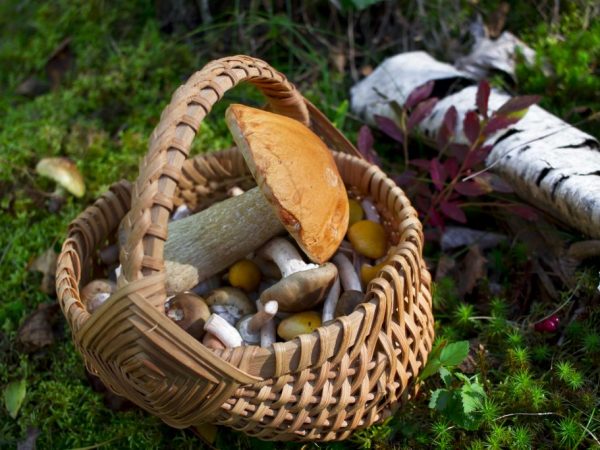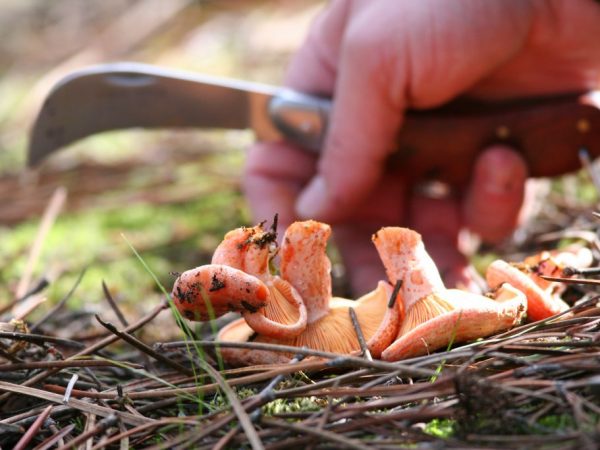Mushroom places of the Tomsk region
Siberia has long been famous for its huge natural resources, minerals, a wide variety of flora and fauna. The collection of so-called wild plants - pine nuts, cranberries, mushrooms - is also widely developed in the region. About 40% of Siberian stocks of "quiet hunting" are mushrooms of the Tomsk region. Where is it better to collect them? Are mushroom pickers aware of secret forest areas where the harvest is especially rich?

Mushroom places of the Tomsk region
Gathering season
The mushroom picking season in the central regions of Russia usually begins in early spring and lasts until late autumn. In the colder climate of the Tomsk region, the first mushrooms appear in June - early July. In the absence of drought, sunny weather and rains, you can harvest up to 3 crops per year:
- 1st collection: June – early July;
- 2nd collection: around August;
- 3rd collection: at the end of September.
Information: The most delicious, containing the maximum amount of valuable and useful substances, are mushrooms harvested in the summer.
Tomsk residents prefer to go in search of mushrooms in pine and coniferous forests. In them you can stumble upon entire families of forest beauties. Therefore, having found one specimen, mushroom pickers should be more careful - a whole group of these amazing spore organisms can grow nearby.
Which grows up first
The first mushrooms grow in Tomsk and the Tomsk region in June - early July. These include:
- Boletus: having appeared at the beginning of summer, the highest yield is obtained from the end of August until the end of the harvesting season (late September). They are eaten boiled, fried, pickled, ideal as a filling for pies and pies, making gravies. The most common places are birch groves. The color of their cap is usually dim, in brown tones.
- Aspen mushrooms: the main plus is its well-recognized appearance, which cannot be confused with any other mushroom, including poisonous. They are characterized by a blue flesh on the cut, which can shock a novice mushroom picker. Boletus boiled, dried, fried, pickled. The main location is birch groves. The common name of boletus and boletus among the people is obabki. Taste qualities in different species are similar and when collecting people do not bother with the exact definition of the species.
- Butterlets: have a slimy (slippery) oily sticky cap, which gave the name to the genus. First courses are cooked from butter, they are fried, salted, pickled, added to the preparation of side dishes, sauces, less often dried. They prefer to grow in coniferous forests, especially in cleared pine forests. The first crop of Tomsk residents is harvested in early June, the harvest lasts about 2 weeks. Boletus reappears at the end of July; their greatest number is reached at the end of August - beginning of September. When processing, it is advisable to remove the skin from the cap.
- White: are considered one of the most delicious and healthy types. The most common places of growth are spruce, pine, oak, birch groves. They are home to the varieties of the same name of the porcini mushroom.They are eaten both fresh and dried: they are boiled, stewed, marinated, fried, stuffed for pies, caviar is prepared. Collect whites from the second decade of June to the last days of September.
Important! You should not take overgrown specimens - because of the processes of decay, decomposition, substances hazardous to health begin to accumulate in them.
July harvest

Ryzhiks can be harvested until the end of October.
In July, in the Tomsk region, mushrooms suitable for pickling and pickling are collected. These include:
- Milk mushrooms: prefer to grow in groups, in soil with a high sand content, near oaks, birches, pines. Only salted foods are eaten. Before salting, they must be soaked in water for 3 days, draining the water at least 2 times daily. This is done to remove the caustic milky juice, which gives the mushroom pulp bitterness.
- Ryzhiki: mushroom pickers especially highlight pine mushroom, or upland. The most common places of growth are meadows overgrown with grass of old pine forests, young pine forests. Canned mushrooms, pickled, salted. The collection takes place until the last days of October.
- Chanterelles: grow up in large families. Marinated, salted, fried (no preliminary cooking is required). They grow from July to October.
Advice: After bringing home the harvested mushroom crop, immediately sort it out, then leave it for 1 hour in salted water at room temperature. This will help get rid of unwanted worms, insects.
Fees for August and September
In the last month of summer - the first autumn month, the most common in Tomsk are:
- Volnushki: found in large quantities, mainly in mixed or deciduous forests. Can only be eaten in salted form. Before cooking, it is necessary to soak the waves in water for up to 4 days, changing the water several times, then rinse thoroughly.
- Russula: It can be found in almost any forest, but most often it grows in the area of road shoulders, in sparse young birch groves that do not have undergrowth. Eaten in boiled, stewed, fried, pickled versions, dried, salted. It is preliminarily recommended to boil the russula for about 7 minutes.
- ABOUTheel aboutsennye, or real honey mushrooms: prefer to grow on stumps, roots, fallen or standing trees, in thickets of nettles. Most often, mushroom pickers find them in birch groves, less often in coniferous forests. Dried, pickled, salted mushrooms are tasty. If hot dishes are prepared from them, then honey mushrooms must first be boiled for half an hour.
Irina Selyutina (Biologist):
For the most part, honey mushrooms are saprophytes, but autumn mushrooms, or real ones, in contrast to them, are real parasites, since they live on living trees and, accordingly, destroy them, using them as food for themselves. There are about 200 plant species on which the autumn mushroom can develop. Cases of its growth are described even on garden peonies, potatoes, gooseberries and cherries. Growing on stumps, real mushrooms can cause a very interesting phenomenon - the night glow of stumps or dead trees. This phenomenon is called bioluminescence. However, nevertheless, today scientists cannot say with certainty what is the reason - some specific function of the fungus, as an organism, or whether it is a side effect of the metabolism of the fungus.
The harvested crop must be processed immediately, clearing it of twigs, sand, needles, etc. It is better to put the specimens found in a bucket, the basket with its legs up - this way they break less.
It is interesting: if you collect mushrooms in the morning, before heating them with the sun's rays, then their shelf life will increase.
Where to look better
Experts say that at present on the map of the city of Tomsk and the Tomsk region can be noted a large number of places where "quiet hunting" will be especially successful:
- from. Kurlek, bordering the Kemerovo region: boletus, boletus, white are found here.
- from. Zorkaltsevo, village Berezkino, s. Baturino, Shegarsky tract, behind d.Voronino: in this area you can collect white, milk mushrooms, boletus.
- forests near Kislovka: rich in moss, sometimes boletus is also found.
- Luchanovsky Bor: visit it for a specific purpose - to pick porcini mushrooms.
- settlement "86 kvartal": locals harvest here moss, white, boletus, chanterelles, aspen mushrooms
- Cape Pavlov, Kolpashevsky district: if you are a lover of milk mushrooms, then this is the place for you.
For those who are problematic to travel outside the city for some reason, you can mark several places on the map where it is possible to harvest a good harvest without leaving city streets and neighborhoods:
- woodland behind the stadium "Polytechnic": it is visited by those wishing to prepare butter and porcini mushrooms.
- Instrument factory: beyond its territory are the possessions of waves, butter, black mushrooms.
- forest behind st. them. Mokrushina: go there and you will take away baskets full of butter and milk mushrooms.
- pharmaceutical enterprise NPO Virion: behind it you can find milk mushrooms, boletus, sometimes white.
Some mushroom pickers found milk mushrooms on the street. named after R. Luxemburg, opposite the railway station "Tomsk-I", behind the Central Department Store.
For those who like to wander through the woods with a basket, we recommend looking for mushrooms in the Tomsk region outside the cities: this will bring a lot of positive emotions thanks to the opportunity to enjoy the beauty of the surrounding nature and reap a rich harvest.


